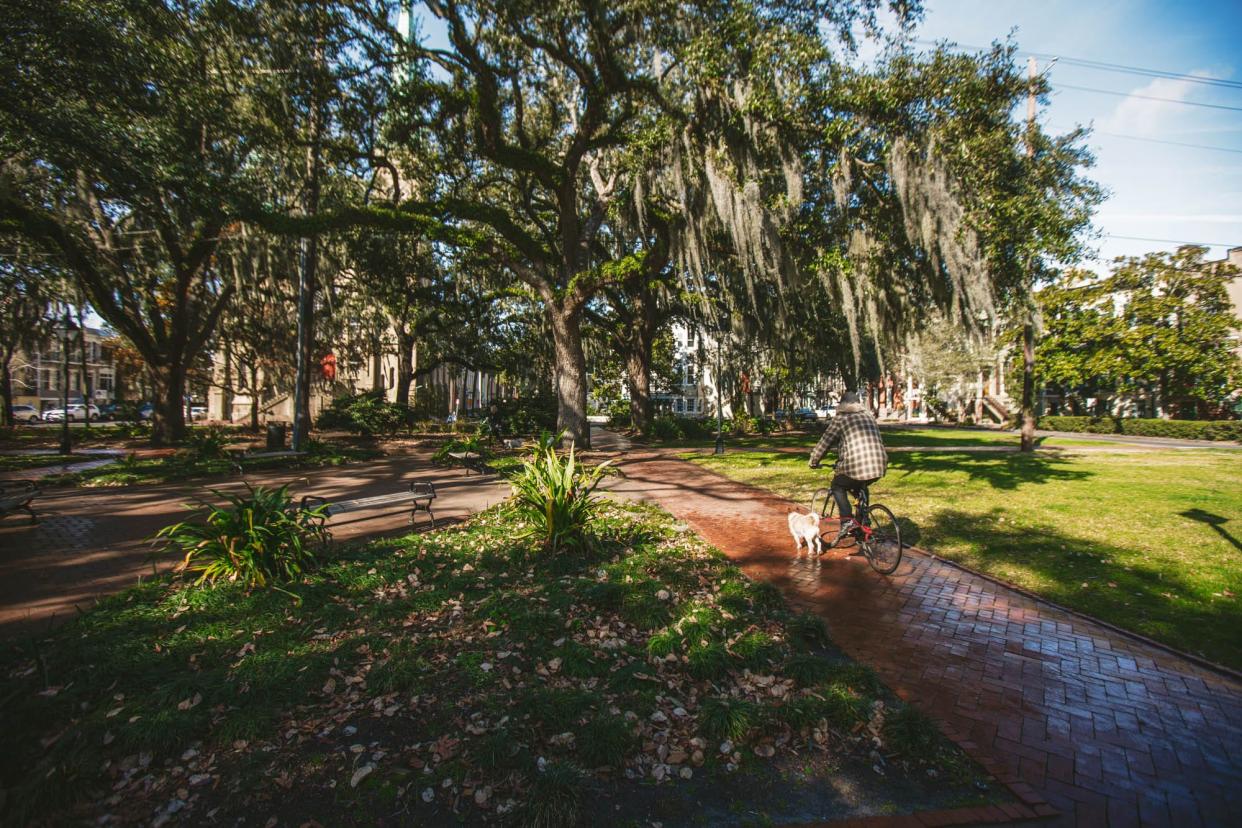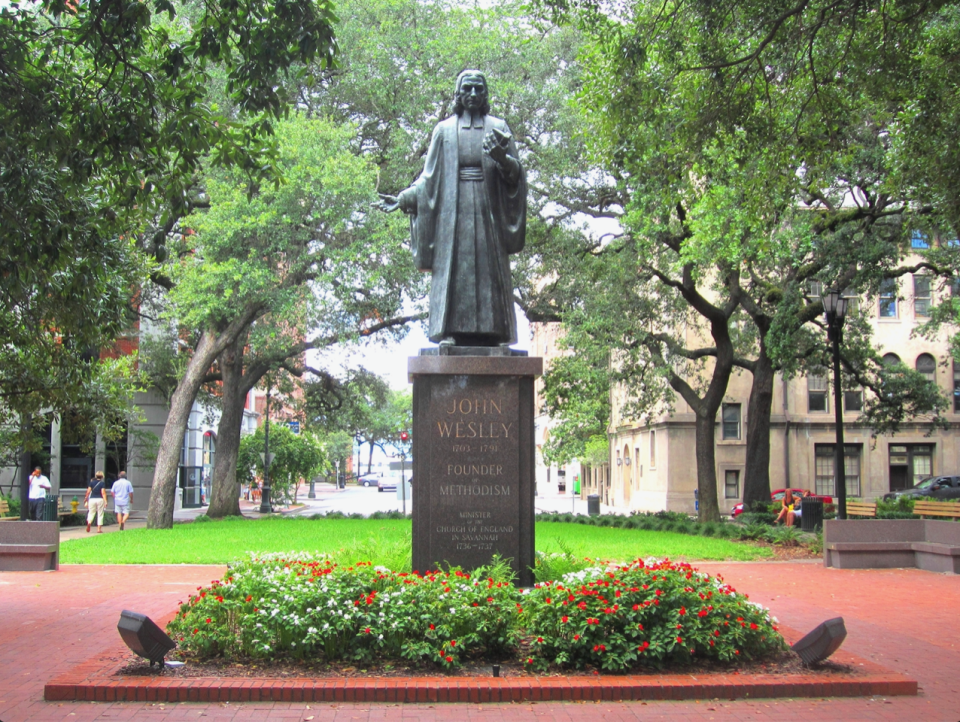Name that square? Savannah mayor unveils 15 new names for square formerly named for Calhoun

- Oops!Something went wrong.Please try again later.
The names of Savannah icons, both the well-known and the obscure, are among the 15 finalists that will be considered in Savannah City Council’s renaming of the Abercorn Street park long known as Calhoun Square.
Civil rights pioneer W.W. Law, renowned female leaders Susie King Taylor, Mary Musgrove and Jane A. DeVeaux, and famed religious figures John Wesley and George Liele topped the list of names revealed Thursday by Savannah Mayor Van Johnson. The public unveiling followed a meeting held Wednesday night regarding the naming process.
Each of the 15 potentials was filed by a member of the public via electronic application.
More on Calhoun Square name controversy: Savannah Council takes up Calhoun Square renaming. For activists, the fight dates back years

Why does the square need a new name?
The square, located at Abercorn and Wayne streets and adjacent to the Massie School and Wesley Monumental United Methodist Church, has gone unidentified since November 2022 when council stripped Calhoun’s name from the greenspace. The move was sparked by nearly two years of protests led by a Savannah activist organization, the Center of Jubilee, Reconciliation and Healing.
The group took issue with Calhoun’s well-known embrace and endorsement of slavery during his time in government office. Between 1811 and 1850, Calhoun served in the U.S. Senate and the U.S. House as well as in the executive branch as secretary of state, secretary of war and vice president.
Calhoun died in 1850, 13 years before the Emancipation Proclamation abolishing slavery in the United States.
“Council determined Calhoun didn’t reflect who we are nor who we want to be,” Mayor Johnson said. “We want to have a name that would serve to inspire our citizens to reflect on individuals or concepts or ideas that have character, value and achievements in Savannah history.
“The removal of Calhoun’s name from the square offers a unique opportunity in history to provide a more inclusive, historical narrative of meeting these goals."
More on Calhoun Square controversy: The road to changing the name of a public space in Savannah is long, and it's meant to be
What are the next steps in the process?
The release of the 15 potential names moves Savannah close to a new name for the square. Over the next three months, two review bodies, the Savannah Park and Tree Commission and the Savannah Historic Site and Monument Commission, will review the applications as well as public comments related to the suggested names and draft recommendations for Savannah City Council.
Council is expected to hold hearings and vote on a new name in meetings in August and September.

What are the 15 names?
Here are the 15 submitted names. Each of the applications, which contain biographies, can be viewed at Savannahga.gov/SquareNaming.
Abbott Square: The name would recognize the contributions of Robert Sengstacke Abbott, who grew up in Savannah in the years following the Civil War. He would go on to found the Chicago Defender, one of the nation’s first and most influential Black-owned newspapers.
Mirault Square: The name is meant to honor Aspasia Cruvellier Mirault, a free Black woman who operated several successful local businesses in the 1830s, 1840s and 1850s.
Casey Square: Dr. John Aloysius Casey was a Savannah physician and a strong advocate and fundraiser for Savannah’s first hospital for Black residents, the Georgia Infirmary. He is also recognized as a "medical martyr" for his work treating local yellow fever patients. He died after contracting the disease in 1819.
Creek Square: Leaders of the Lower Creek Indian tribe inhabited the land where Savannah now sits and forged the Treaty of Savannah with the city’s founder, Gen. James Oglethorpe, in 1733.
DeVeaux Square: Jane A. DeVeaux was an educator who led a secret school for Savannah’s Black children in the mid-1800s. Her school operated for 30 years.
Leile Square: The Rev. George Leile was the first pastor of Savannah’s First African Baptist Church. Leile was a slave freed prior to the American Revolution and founded the First Colored Baptist Church in 1777. He later took his ministry to Jamaica and is thought to be among the first missionaries in U.S. history.
Hostess City of the South Square: The name would give formal recognition to Savannah’s often-used moniker.
Leo Center Square: Center was a prominent member of the Savannah Jewish community and served five terms as a city alderman in the 1970s and 1980s.
Major Clayton Carpenter Square: An Army aviator stationed at Hunter Army Airfield, Carpenter was killed in a training accident in 2014. He was a West Point graduated and was nominated by one of the men who served on his helicopter crew and was aboard the aircraft during the fatal crash.
Musgrove Square: Mary Musgrove was a Creek Indian woman who served as cultural liaison between Oglethorpe, the founder of the Georgia colony, and Lower Creek Indian leaders, particularly Tomochichi. She was also a successful businesswoman who operated trading posts in and around Savannah in the early 1700s.
Sheftall Square: Mordecai Sheftall was an early Jewish settler in Savannah and a founder of Congregation Mickve Israel, based in a temple located one block west of the square formerly named for Calhoun. Sheftall’s descendants have a long history of service to Savannah’s Jewish community.
Susie King Taylor Square: Taylor was a nurse and educator, tending to Union Army wounded during the Civil War and teaching soldiers how to read and write. Following the war, she operated two schools for Black children in Savannah.
The Seven Sisters Square: The name would recognize the seven Savannah women who sparked the city’s historic preservation movement by saving the Davenport House in the 1950s. The women are Anna Colquitt Hunter, Katherine Judkins Clark, Elinor Adler Dillard, Lucy Barrow McIntire, Dorothy Ripley Roebling, Nola McEvoy Roos and Jane Adair Wright.
Wesley Square: John Wesley is known as the father of Methodism and started his church after coming to Savannah in 1735.
W.W. Law Square: Westley Wallace Law was Savannah’s most prominent leader during the civil rights movement. He headed the Savannah NAACP and organized the many sit-ins, wade-ins and other non-violent protests that led to the city’s desegregation in 1963, before passage of the Civil Rights Act of 1964.
This article originally appeared on Savannah Morning News: Savannah to consider 15 names for renaming of Calhoun Square

